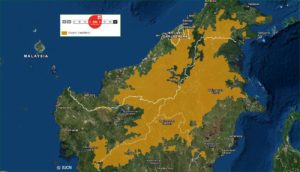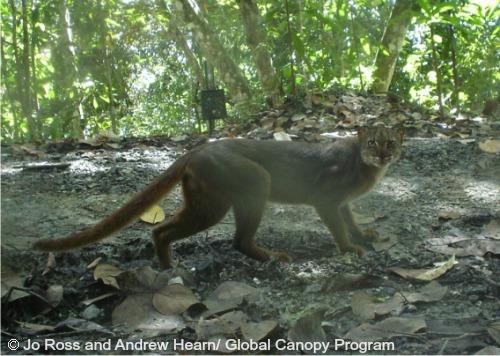- HB Length: Appr. 53 cm (21″)
- Tail Length: Appr. 39 cm (15″)
- Height: Unknown
- Weight: 3-4 kg (6-9 lbs)
- Pop. Trend: Decreasing
The Borneo Bay Cat Catopuma badia is the mystery member of the cat family. Next to nothing is known about their ecology or distribution.
Previously thought to be a small island form of the Asiatic Golden Cat Catopuma temminckii, genetic testing has revealed the Bay Cat is a unique species, and therefore a highly endangered one.
About the size of a large house cat, Bay Cats have uniform, dark, chestnut red fur faintly speckled with black markings, and spots on the lighter golden brown underside and limbs. A second colour phase of dark, bluish slate-grey has also been recorded, as have black or melanistic specimens. The short, rounded head is dark greyish brown with two dark stripes originating from the corner of each eye, and the back of the head has a dark ‘M’ shaped marking. The backs of the short rounded ears are dark greyish. The underside of the chin is white and there are two faint brown stripes on the cheeks. Their long, tapering tail has a yellowish streak down its length on the underside, becoming pure white at the tip, which is marked with a small black spot.
Distribution

The Bay Cat is found only on the island of Borneo, and appears to be widely distributed on the island. An extensive, contiguous forested area of interior Borneo is thought to be suitable habitat for these cats.
Both lowland and upland forests are thought to be important habitats for Bay Cats. Lower montane and swamp forests are considered poor habitat but may function as wildlife corridors. All other non-forested habitat, oil palm plantations and burnt forest areas are considered unsuitable.
Ecology
During their study of the five felids on Borneo, researchers from the Bornean Clouded Leopard Program obtained camera trap photos of the Bay Cat, which were obtained at midday, early morning and at night.
Scientists from this project observed two Bay Cats at night on the roadside in an area that had been selectively logged ten years previously. Road edges contain dense small trees and high numbers of rodents, making them ideal hunting areas.
While the increasing use of camera traps on Borneo is slowly yielding more detection of the Bay Cat, a number of surveys in areas predicted to be high suitability failed to detect it. A detailed field study on the Bay Cat is urgently required.
In 1992, an adult female Bay Cat was brought into the Sarawak Museum, alive but at the point of death, dying soon after. The cat had apparently been caught by native trappers and held in captivity for some months. The appearance of this specimen offered the first opportunity to look at a whole animal.
In 1998, BBC Wildlife Magazine published the first photo photograph of a live Borneo Bay Cat. This cat was weighed, measured, photographed, given a physical examination, dewormed and released back into the forest.
Conservation
Outside of protected areas, habitat loss due to commercial logging and palm oil plantations is the main threat to the Bay Cat. A collaborative effort between an Indonesian timber company and the Nature Conservancy is providing sustainable development, which includes monitoring the impact of tree removal (5 trees per hectare) on wildlife.
The Borneo Bay Cat is forest-dependent, and forest cover on the island of Borneo, if current deforestation rates continue, is projected to decline from 50% to less than one-third by 2020. Some forest areas are currently declining by 5% per year.
Wildlife traders are aware of the cat’s rarity, and they have been captured illegally from the wild for the skin and pet markets. Poaching of the cats’ prey species is a growing problem. There is legal protection of the Borneo Bay cat within Borneo, but enforcement to actually stop trade is minimal
Compare this cat to the Asiatic golden cat.
Range map IUCN Red List (2008)
Updated 2016


21 Responses